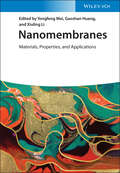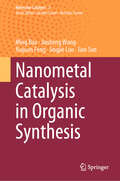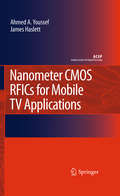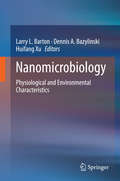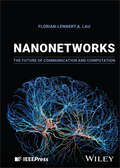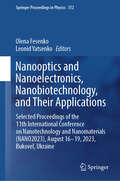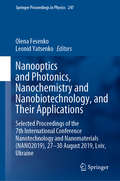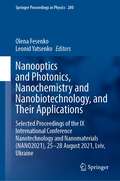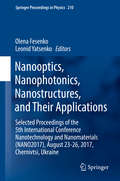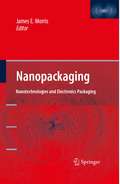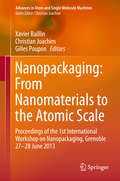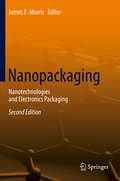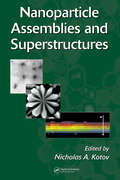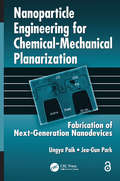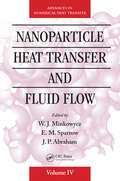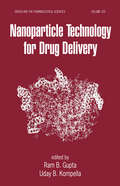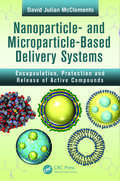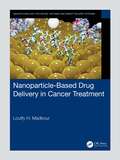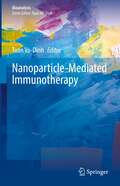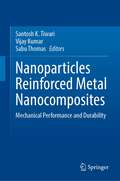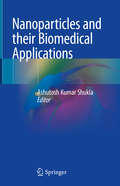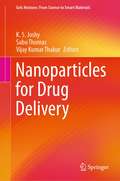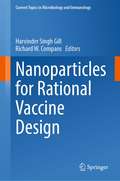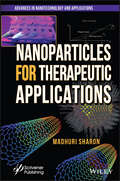- Table View
- List View
Nanomembranes: Materials, Properties, and Applications
by Yongfeng Mei Gaoshan Huang Xiuling LiNanomembranes Provides a thorough overview of the field of nanomembranes, covering materials science, fabrication processes, properties, and applications In recent years, the unique nature of the nanomembrane has led to new technology and applications in areas including flexible electronics, photonics, robotics, biology, microelectromechanical systems, and lab-on-a-chip (LOC) devices. Highly suitable for assembling three-dimensional structures, the nanomembrane can be integrated into devices and systems using conventional thin film technology. Nanomembranes: Materials, Properties, and Applications is an up-to-date review of recent advances in the rapidly expanding area within nanoscience and technology. Edited by leading researchers, the book covers the fabrications, properties, applications, design concepts, and challenges of nanomembranes and other nano-scale assembled structures. In-depth chapters address topics including three- and four-dimensional origami, nanomembrane-based transient electronics, development of inorganic flexible electronics, magnetic nanomembranes, bio-applications of three-dimensional scaffolds, nanomembrane-based micro and nanorobots, passive electronic components based on self-rolled-up nanomembranes, and more. Covers nanomembranes as well as nanostructures made from semiconductor, metal, insulator, polymer, and composite materials Provides broad overview of two-dimensional materials and assembled structures including origami and kirigami structures Explores applications of nanomembrane such as batteries, supercapacitors, robotics, electronics, and cell scaffolding Discusses nanomembranes made from polymeric materials, mechanical forces during deformation, and assembly of nanomembranes, Addresses monolayer two-dimensional materials such as graphene and transition metal dichalcogenides Nanomembranes: Materials, Properties, and Applications is an invaluable resource for material scientists, engineers, physicists, and chemists in academia and industry, and an excellent text for graduate students and researchers across disciplines with interest in the rapidly growing field.
Nanometal Catalysis in Organic Synthesis (Molecular Catalysis #3)
by Jian Sun Xiujuan Feng Ming Bao Jiasheng Wang Jingjie LuoThe book explains principles and fundamentals of nano-metal catalysis in organic synthesis and highlights the current developments and future potential of the green chemistry-oriented applications of metal nanocatalysts. It consists of six chapters, including introduction; organic synthesis catalyzed by metal nanoparticles; organic synthesis catalyzed by metal nanoclusters; organic synthesis catalyzed by metal single atoms; organic synthesis catalyzed by nanoporous metals; and conclusions and outlook. It introduces the latest advances in preparation, characterization, and catalytic application of metal nanocatalysts, elucidates the catalytic mechanisms of various metal nanocatalysts, and inspires rational catalyst design. This book is interesting and useful to a wide readership in various fields of chemical science and engineering.
Nanometer CMOS RFICs for Mobile TV Applications
by Ahmed A. Youssef James HaslettNanometer CMOS RFICs for Mobile TV Applications focuses on how to break the trade-off between power consumption and performance (linearity and noise figure) by optimizing the mobile TV front-end dynamic range in three hierarchical levels: the intrinsic MOSFET level, the circuit level, and the architectural level. It begins by discussing the fundamental concepts of MOSFET dynamic range, including nonlinearity and noise. It then moves to the circuit level introducing the challenges associated with designing wide-dynamic range, variable-gain, broadband low-noise amplifiers (LNAs). The book gives a detailed analysis of a new noise-canceling technique that helps CMOS LNAs achieve a sub - 2 dB wideband noise figure. Lastly, the book deals with the front-end dynamic range optimization process from the systems perspective by introducing the active and passive automatic gain control (AGC) mechanism.
Nanomicrobiology
by Larry L. Barton Dennis A. Bazylinski Huifang XuThis book is devoted to nanomicrobiology and the nanosystems of bacteria. The initial chapter discusses some of the controversies in the geochemical and biomedical fields associated with the reports of nanobacteria in the environment. Current knowledge of several internal and surface structures of bacteria is addressed in this book. Included are chapters discussing carboxysomes, S-layers, gliding motility of bacteria, and aggregation of iron to produce nano-magnetite. Information about the activities of outer membrane vesicles produced by Gram-negative bacteria is discussed as a benefit to bacteria that produce it and some potential industrial applications are presented. A broad review of bacterial-mineral interactions is addressed in a chapter of metallic nanoparticles and colloids production by bacterial reduction of soluble redox active elements. The structures of bacterial nanowires are discussed and their application in extra-cellular electron transport is reviewed. Nanomotor activities of bacteria are discussed as pertains to the mechanics of flagellar rotation, production of energy by ATP synthase, DNA packing, and translocation of proteins across membranes by secretion systems. The rapidly evolving field of nanosystem technology is embracing many areas, and it is the hope that this book will stimulate the use of bacterial nanostructures for future developments in nanotechnology.
Nanonetworks: The Future of Communication and Computation
by Florian-Lennert A. LauLearn the basics—and more—of nanoscale computation and communication in this emerging and interdisciplinary field The field of nanoscale computation and communications systems is a thriving and interdisciplinary research area which has made enormous strides in recent years. A working knowledge of nanonetworks, their conceptual foundations, and their applications is an essential tool for the next generation of scientists and network engineers. Nanonetworks: The Future of Communication and Computation offers a thorough, accessible overview of this subject rooted in extensive research and teaching experience. Offering a concise and intelligible introduction to the key paradigms of nanoscale computation and communications, it promises to become a cornerstone of education in these fast-growing areas. Readers will also find: Detailed treatment of topics including network paradigms, machine learning, safety and securityCoverage of the history, applications, and important theories of nanonetworks researchExamples and use-cases for all formulas and equations Nanonetworks is ideal for advanced undergraduate and graduate students in engineering and science, as well as practicing professionals looking for an introductory book to help them understand the foundations of nanonetwork systems.
Nanooptics and Nanoelectronics, Nanobiotechnology, and Their Applications: Selected Proceedings of the 11th International Conference on Nanotechnology and Nanomaterials (NANO2023), August 16-19, 2023, Bukovel, Ukraine (Springer Proceedings in Physics #312)
by Leonid Yatsenko Olena FesenkoThis book highlights some of the latest advances in nanotechnology and nanomaterials from leading researchers in Ukraine, Europe, and beyond. It features contributions from participants of the 11th International Conference Nanotechnology and Nanomaterials (NANO-2023) in Bukovel, Ukraine on August 16-19, 2023 organized by the Institute of Physics of the National Academy of Sciences of Ukraine, University of Tartu (Estonia), University of Turin (Italy), and Pierre and Marie Curie University (France). Worldwide experts present scientific achievements in key topics such as nanophysics, nanophotonics, nanooptics, nanoplasmonics, nanoelectronics, and nanobiotechnology. The book explores a significant branch of nanoscience and introduces new opportunities for synergistic research. Specifically, it: • presents new methods for the synthesis and characterization of nanomaterials, nanocomposites and various nanostructures • presents microscopy, spectroscopy and laser imaging techniques for nanomaterials and nanocomposites • presents novel advances in nanophysics, nanooptics, nanophotonics, and nanoplasmonics • covers nanobiotechnology and nanochemistry, and their applications. This Book is essential reading for advanced undergraduate and graduate students, senior scientists, and industry representatives. It includes up-to-date results of investigations in nanotechnology and nanomaterials, along with promising its applications from nanophysics to nanomedicine.
Nanooptics and Photonics, Nanochemistry and Nanobiotechnology, and Their Applications: Selected Proceedings of the 7th International Conference Nanotechnology and Nanomaterials (NANO2019), 27 – 30 August 2019, Lviv, Ukraine (Springer Proceedings in Physics #247)
by Leonid Yatsenko Olena FesenkoThis book highlights some of the latest advances in nanotechnology and nanomaterials from leading researchers in Ukraine, Europe and beyond. It features contributions presented at the 7th International Science and Practice Conference Nanotechnology and Nanomaterials (NANO2019), which was held on August 27–30, 2019 at Lviv Polytechnic National University, and was jointly organized by the Institute of Physics of the National Academy of Sciences of Ukraine, University of Tartu (Estonia), University of Turin (Italy), and Pierre and Marie Curie University (France). Internationally recognized experts from a wide range of universities and research institutions share their knowledge and key findings on material properties, behavior, and synthesis. This book’s companion volume also addresses topics such as nano-optics, energy storage, and biomedical applications.
Nanooptics and Photonics, Nanochemistry and Nanobiotechnology, and Their Applications: Selected Proceedings of the 8th International Conference Nanotechnology and Nanomaterials (NANO2020), 26–29 August 2020, Lviv, Ukraine (Springer Proceedings in Physics #264)
by Leonid Yatsenko Olena FesenkoThis book highlights some of the latest advances in nanotechnology and nanomaterials from leading researchers in Ukraine, Europe and beyond. It features contributions presented at the 8th International Science and Practice Conference Nanotechnology and Nanomaterials (NANO2020), which was held on August 26–29, 2020 at Lviv Polytechnic National University, and was jointly organized by the Institute of Physics of the National Academy of Sciences of Ukraine, University of Tartu (Estonia), University of Turin (Italy), and Pierre and Marie Curie University (France). Internationally recognized experts from a wide range of universities and research institutions share their knowledge and key findings on material properties, behavior, and synthesis. This book’s companion volume also addresses topics such as nano-optics, energy storage, and biomedical applications.
Nanooptics and Photonics, Nanochemistry and Nanobiotechnology, and Their Applications: Selected Proceedings of the IX International Conference Nanotechnology and Nanomaterials (NANO2021), 25–28 August 2021, Lviv, Ukraine (Springer Proceedings in Physics #280)
by Leonid Yatsenko Olena FesenkoThis book highlights some of the latest advances in nanotechnology and nanomaterials from leading researchers in Ukraine, Europe and beyond. It features contributions presented at the 8th International Science and Practice Conference Nanotechnology and Nanomaterials (NANO2020), which was held on August 25–28, 2021 at Lviv Polytechnic National University, and was jointly organized by the Institute of Physics, the National Academy of Sciences of Ukraine, Lviv Polytechnic National University, University of Tartu (Estonia), University of Turin (Italy), Pierre and Marie Curie University (France), European Profiles S.A. (Greece), Representation of the Polish Academy of Sciences in Kyiv, University of Angers (France), Ruprecht Karl University of Heidelberg (Germany). Internationally recognized experts from a wide range of universities and research institutions share their knowledge and key findings on material properties, behavior, and synthesis. This book’s companion volume also addresses topics such as nano-optics, energy storage, and biomedical applications.
Nanooptics, Nanophotonics, Nanostructures, and Their Applications: Selected Proceedings of the 5th International Conference Nanotechnology and Nanomaterials (NANO2017), August 23-26, 2017, Chernivtsi, Ukraine (Springer Proceedings in Physics #210)
by Leonid Yatsenko Olena FesenkoThis book presents some of the latest achievements in nanotechnology and nanomaterials from leading researchers in Ukraine, Europe, and beyond. It features selected peer-reviewed contributions from participants in the 5th International Science and Practice Conference Nanotechnology and Nanomaterials (NANO2017) held in Chernivtsi, Ukraine on August 23-26, 2017. The International Conference was organized jointly by the Institute of Physics of the National Academy of Sciences of Ukraine, Ivan Franko National University of Lviv (Ukraine), University of Tartu (Estonia), University of Turin (Italy), and Pierre and Marie Curie University (France). Internationally recognized experts from a wide range of universities and research institutions share their knowledge and key results on topics ranging from nanooptics and nanoplasmonics to interface studies. This book's companion volume also addresses topics such as energy storage and biomedical applications.
Nanopackaging
by James E. MorrisThis book presents a comprehensive overview of nanoscale electronics and systems packaging, and covers nanoscale structures, nanoelectronics packaging, nanowire applications in packaging, and offers a roadmap for future trends. Composite materials are studied for high-k dielectrics, resistors and inductors, electrically conductive adhesives, conductive "inks," underfill fillers, and solder enhancement. The book is intended for industrial and academic researchers, industrial electronics packaging engineers who need to keep abreast of progress in their field, and others with interests in nanotechnology. It surveys the application of nanotechnologies to electronics packaging, as represented by current research across the field.
Nanopackaging: From Nanomaterials to the Atomic Scale
by Christian Joachim Xavier Baillin Gilles PouponThis book is a first attempt to merge two different communities: scientists and technologists. Therefore, it is not a general overview covering all the fields of nanopackaging, but is mainly focused on two topics. The first topic deals with atomic scale devices or circuit requirements, as well as related recent technological developments; for example, surface science engineering and atomic scale interconnects studies. The second main part of the book brings CNT nano-materials solutions for resolving interconnect or thermal management problems in microelectronics device packaging. This book is not just useful for those who attended the International Workshop on Nanopackaging in Grenoble, but can provide valuable information to scientists and technologists in the nanopackaging community.
Nanopackaging: Nanotechnologies and Electronics Packaging
by James E. MorrisThis book presents a comprehensive overview of nanoscale electronics and systems packaging, and covers nanoscale structures, nanoelectronics packaging, nanowire applications in packaging, and offers a roadmap for future trends. Composite materials are studied for high-k dielectrics, resistors and inductors, electrically conductive adhesives, conductive "inks," underfill fillers, and solder enhancement. The book is intended for industrial and academic researchers, industrial electronics packaging engineers who need to keep abreast of progress in their field, and others with interests in nanotechnology. It surveys the application of nanotechnologies to electronics packaging, as represented by current research across the field.
Nanoparticle Assemblies and Superstructures
by Nicholas A. KotovCubes, triangular prisms, nano-acorn, nano-centipedes, nanoshells, nano-whiskers. . . . Now that we can create nanoparticles in a wide variety of shapes and morphologies, comes the next challenge: finding ways to organize this collection of particles into larger and more complex systems. Nanoparticle Assemblies and Superstructures, edit
Nanoparticle Engineering for Chemical-Mechanical Planarization (Open Access): Fabrication of Next-Generation Nanodevices
by Ungyu Paik Jea-Gun ParkIn the development of next-generation nanoscale devices, higher speed and lower power operation is the name of the game. Increasing reliance on mobile computers, mobile phone, and other electronic devices demands a greater degree of speed and power. As chemical mechanical planarization (CMP) progressively becomes perceived less as black art and more as a cutting-edge technology, it is emerging as the technology for achieving higher performance devices.Nanoparticle Engineering for Chemical-Mechanical Planarization explains the physicochemical properties of nanoparticles according to each step in the CMP process, including dielectric CMP, shallow trend isolation CMP, metal CMP, poly isolation CMP, and noble metal CMP. The authors provide a detailed guide to nanoparticle engineering of novel CMP slurry for next-generation nanoscale devices below the 60nm design rule. They present design techniques using polymeric additives to improve CMP performance. The final chapter focuses on novel CMP slurry for the application to memory devices beyond 50nm technology.Most books published on CMP focus on the polishing process, equipment, and cleaning. Even though some of these books may touch on CMP slurries, the methods they cover are confined to conventional slurries and none cover them with the detail required for the development of next-generation devices. With its coverage of fundamental concepts and novel technologies, this book delivers expert insight into CMP for all current and next-generation systems.
Nanoparticle Heat Transfer and Fluid Flow (Computational & Physical Processes in Mechanics & Thermal Scienc)
by W. J. Minkowycz E. M. Sparrow J. P. AbrahamFeaturing contributions by leading researchers in the field, Nanoparticle Heat Transfer and Fluid Flow explores heat transfer and fluid flow processes in nanomaterials and nanofluids, which are becoming increasingly important across the engineering disciplines. The book covers a wide range, from biomedical and energy conversion applications to mate
Nanoparticle Technology for Drug Delivery (Drugs and the Pharmaceutical Sciences)
by Uday B. Kompella Ram B. GuptaNanoparticles, products of nanotechnology, are of increasing interest to the pharmaceutical community. They can increase drug solubility, enhance bioavailability, allow tissue targeting, offer decreased side-effects, and improve therapeutic efficacy. Presenting the most pertinent and practical issues in the manufacturing and biological application
Nanoparticle- and Microparticle-based Delivery Systems: Encapsulation, Protection and Release of Active Compounds
by David Julian McClementsThis book covers the formation, properties, characterization, and application of different kinds of colloidal delivery systems that can be utilized within the food industry, including surfactant-based, emulsion-based, and biopolymer-based systems. The book takes a traditional colloid science approach to the subject with particular emphasis on the practical aspects of formulation of particulate and emulsion-based delivery systems for pharmaceutical and food applications. It covers active ingredients drawn from proteins, carbohydrates, and lipids as well as mineral-based active ingredients. The book describes particle characteristics and explains mechanical particle fabrication methods.
Nanoparticle-Based Drug Delivery in Cancer Treatment (Nanotechnology for Drugs, Vaccines and Smart Delivery Systems)
by Loutfy H. MadkourThe careful choice of nanoparticles as targets and in drug delivery routes enhances therapeutic efficacy in cancer. Nanoparticle-Based Drug Delivery in Cancer Treatment discusses nanotechnological developments of interfering RNA-based nanoparticles, delivery vehicles, and validated therapeutic RNAi–molecular target interactions and explains the results of clinical and preclinical trials. The book also gives strategies for universal methods of constructing hybrid organic–inorganic nanomaterials that can be widely applied in the biomedical field. Key Features: Reviews recent advances of nanoparticle-mediated siRNA delivery systems and their application in clinical trials for cancer therapy Focuses on material platforms that establish NPs and both localized and controlled gene silencing Emphasizes the most promising systems for clinical application Surveys progress in nanoparticle-based nanomedicine in cancer treatment Describes the most advanced of the nonviral nanocarriers for delivery of oligonucleotides to malignant blood cancer cells This book is a valuable resource for researchers, professors, and students researching drug delivery, gene carriers, cancer therapy, nanotechnology, and nanomaterials.
Nanoparticle-Mediated Immunotherapy (Bioanalysis #12)
by Tuan Vo-DinhThis book is intended to serve as an authoritative reference source for a broad audience involved in the research, teaching, learning, and practice of nanotechnology in immunotherapy. The combination of nanotechnology and immunotherapy is recognized as a promising treatment modality. In particular, the use of nanoparticles in immunotherapy has attracted increased attention for their unique efficacy and specificity in cancer treatment. A wide variety of nanoparticles, such as polymeric and liposomal nanosystems, carbon nanotubes, and gold nanoparticles have provided important nanoplatforms for immunotherapeutic approaches. They have been shown to improve delivery and efficacy of immunotherapeutic agents such as vaccines or adjuvants. Nanoparticle-mediated thermal therapy has demonstrated the effectiveness for precise tumor cell ablation, radio-sensitization of hypoxic regions, enhancement of drug delivery, activation of thermosensitive agents, and enhancement of the immune system. Plasmonic nanoparticles are a special type of metallic nanoparticles that has received great interest due to their enhanced optical and electromagnetic properties and their superior capacity to convert photon energy into heat for selective photothermal therapy at the nanoscale level. Nanoparticle sizes can also be controlled such that they accumulate preferentially in tumors due to the enhanced permeability and retention effect of tumor vasculature. Various nanosystems such as gold nanoparticles have also been shown to stimulate the immune system. Immunotherapies could thus synergistically benefit from the combination with targeted nanoparticle-mediated photothermal therapies, especially when hyperthermia around immune-checkpoint inhibitors in the tumor bed is combined with precise thermal ablation of cancer cells. Of great importance is the possibility that such an approach can induce long-term immunological memory that can provide protection against tumor recurrence long after treatment of the initial tumors, like an ‘anticancer vaccine’. Nanoparticle-mediated immunotherapy could lead to an entirely new treatment paradigm that challenges traditional surgical resection approaches for many cancers and metastases.
Nanoparticles Reinforced Metal Nanocomposites: Mechanical Performance and Durability
by Sabu Thomas Vijay Kumar Santosh K. TiwariThis book highlights recent developments related to fabrication and utilization of nanoparticle-engineered metal matrices and their composites linked to the heavy industries, temperature fasteners, high-pressure vessels, and heavy turbines, etc. The mechanical properties of newly developed metallic composites are discussed in terms of tensile modulus, hardness, ductility, crack propagation, elongation, and chemical inertness. This book presents the design, development, and implementation of state-of-the-art methods linked to nanoparticle-reinforced metal nanocomposites for a wide variety of applications. Therefore, in a nutshell, this book provides a unique platform for researchers and professionals in the area of nanoparticle-reinforced metal nanocomposites.
Nanoparticles and their Biomedical Applications
by Ashutosh Kumar ShuklaNanotechnology is expected to bring revolutionary changes in a variety of fields. This volume describes nanoparticles and their biomedical applications, and covers metal nanoparticles, metal oxide nanoparticles, rare earth based nanoparticles and graphene oxide nanoparticles. It elaborates on a number of biomedical applications, including therapeutic applications. It addresses the topic of green synthesis, in view of increasing health and environmental concerns.
Nanoparticles for Drug Delivery (Gels Horizons: From Science to Smart Materials)
by Sabu Thomas Vijay Kumar Thakur K. S. JoshyThis book introduces the reader to drug delivery with specific emphasis on the use of nanoparticles. It covers properties, characterization, and preparation of different types of nanoparticles and discusses recent advances in their structural design and biomedical application, as well as the issues and challenges associated with their design and use. Some of the topics covered include the potential application of nanoparticles in biomedical fields, hazards associated with use of nanoparticles for drug delivery, size-dependent factors in drug delivery applications, different organic, inorganic and their hybrid systems used in drug delivery, etc. It also highlights use of nanoparticles in controlled and targeted drug delivery, and their application in stimuli-responsive, especially pH-responsive, drug release. Additionally, it also focuses on biomimetic nanoparticles, challenges faced in the designing of nanoparticles for drug delivery in cancer, viral and bacterial diseases. The contents of this volume will be useful to researchers and professionals working on advances in targeted drug delivery systems.
Nanoparticles for Rational Vaccine Design (Current Topics in Microbiology and Immunology #433)
by Richard W. Compans Harvinder Singh GillThis book introduces nanoparticles as a powerful platform for vaccine design. Current challenges in vaccine development are discussed and the unique advantages nanoparticles provide in overcoming these challenges are explored. The authors offer fascinating insights into the immunological assets of using nanoparticles as delivery vehicles or adjuvants and present different materials that are being used in nanoparticle-based vaccine development, covering peptides, proteins, polymers, virus-like particles, and liposomes.Its contemporary research insights and practical examples for applications make this volume an inspiring read for researchers and clinicians in vaccinology and immunology. Chapter "Liposome Formulations as Adjuvants for Vaccines" is available open access under a Creative Commons Attribution 4.0 International License via link.springer.com.
Nanoparticles for Therapeutic Applications (Advances in Nanotechnology and Applications)
by Madhuri SharonNANOPARTICLES FOR THERAPEUTIC APPLICATIONS The main goal of this book is to provide information on theranostic applications of various nanomaterials for different diseases with self-explanatory illustrations and fundamental descriptions of a plethora of properties of molecular traits. The author has written a fascinating book on research topics and fundamentals in the cross-disciplinary area of nanotechnology and bioscience in which she successfully fuses otherwise divergent research topics of this rapidly emerging area. The book deals with the use of nanomaterials for combatting various diseases and disorders of the human body. The three chapters of the first part of this book deal with the areas in which nanotechnology has contributed to nanomedicine. In the second part, different disorders like cancer, neurodegenerative diseases, genetic diseases, infectious diseases, cardiovascular disorders, eye, dentistry, bone, and cartilage-affecting diseases are discussed. In the chapters related to a disease or disorder of a particular organ, a basic brief introduction to them is given as well. Audience The book will be read by researchers, scientists, and graduate students in biotechnology, nanotechnology, materials science, and nanomedicine/biomedicine.
